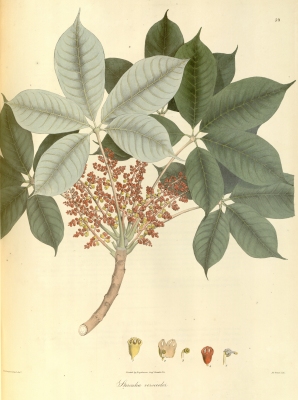Sterculia versicolor
Wall.
Malvaceae
Clompanus versicolor Kuntze
Southwellia versicolor (Wall.) Wight
Common Name:
General Information
Sterculia versicolor is a tree with a spreading canopy, growing up to 5 metres tall[
506- Title
- The Flora of British India. (in 7 volumes)
- Publication
-
- Author
- Hooker J.D.
- Website
- http://www.biodiversitylibrary.org
- Publisher
- L.Reeve & Co.; London
- Year
- 1872 - 1897
- ISBN
-
- Description
- Rather dated, but has some information on plant uses. It can be downloaded from the Internet.
].
The plant is harvested from the wild as a source of fibre. It is sometimes cultivated in S India gardens[
].
Known Hazards
None known
Botanical References
506- Title
- The Flora of British India. (in 7 volumes)
- Publication
-
- Author
- Hooker J.D.
- Website
- http://www.biodiversitylibrary.org
- Publisher
- L.Reeve & Co.; London
- Year
- 1872 - 1897
- ISBN
-
- Description
- Rather dated, but has some information on plant uses. It can be downloaded from the Internet.
Range
E. Asia - Bangladesh, northeast India, Myanmar, Thailand.
Habitat
Limestone rocks in drier forests[
146- Title
- A Manual of Indian Timbers.
- Publication
-
- Author
- Gamble. J. S.
- Publisher
- Bishen Singh Mahendra Pal Singh
- Year
- 1972
- ISBN
- -
- Description
- First written in the 19th century, but still a classic, giving a lot of information on the uses and habitats of Indian trees. Not for the casual reader.
,
506- Title
- The Flora of British India. (in 7 volumes)
- Publication
-
- Author
- Hooker J.D.
- Website
- http://www.biodiversitylibrary.org
- Publisher
- L.Reeve & Co.; London
- Year
- 1872 - 1897
- ISBN
-
- Description
- Rather dated, but has some information on plant uses. It can be downloaded from the Internet.
].
Properties
| Other Uses Rating |      |
| Habit | Tree |
| Height | 5.00 m |
| Cultivation Status | Ornamental, Wild |
Cultivation Details
Not known
Edible Uses
Although we have seen no specific information for this species, the large seeds of many species in this genus are used for food. Usually cooked, they are rich in oil and have a flavour described by some as like peanuts[
K- Title
- Plants for a Future
- Author
- Ken Fern
- Description
- Notes from observations, tasting etc at Plants For A Future and on field trips.
].
Medicinal
None known
Other Uses
A fibre obtained from the bark is used for making ropes and cordage[
].
Propagation
A physical dormancy caused by the hard seed coat of the mature seeds of many species in this genus can be overcome by scarifying the seed. This is carried out by cutting away or abrading some of the seed coat to allow the ingress of water, though great care must be taken not to damage the embryo[
]. The aril surrounding the seed should also be removed - this is easiest when it has been softened through soaking in water[
]. The seeds germinate optimally at temperatures between 20 - 30°c. They can be sown in a nursery seedbed or in containers. A germination rate of about 95%, occurring within about 2 weeks can be expected if the seed has been properly treated[
].
If you have any useful information about this plant, please leave a comment. Comments have to be approved before they are shown here.


 Useful Tropical Plants Database 2014 by
Ken Fern,
web interface by
Ajna Fern
with help from
Richard Morris.
Useful Tropical Plants Database 2014 by
Ken Fern,
web interface by
Ajna Fern
with help from
Richard Morris.